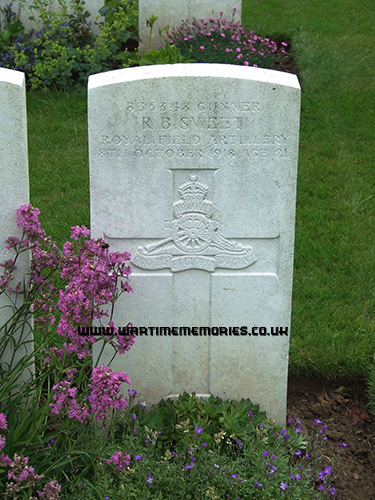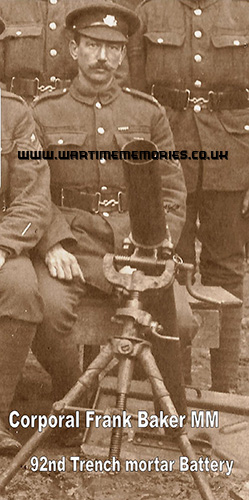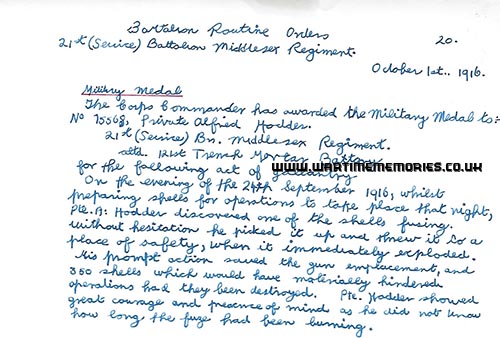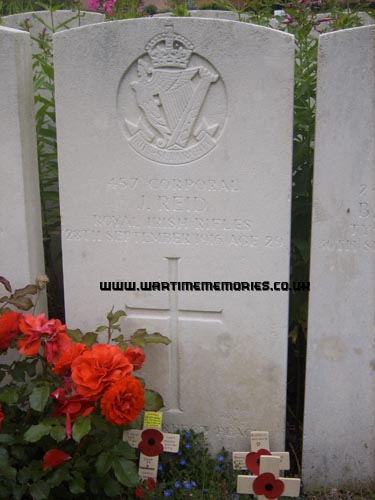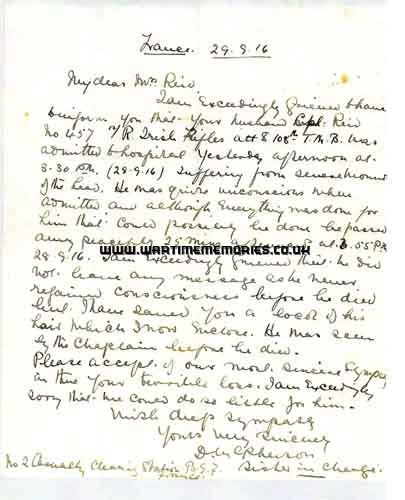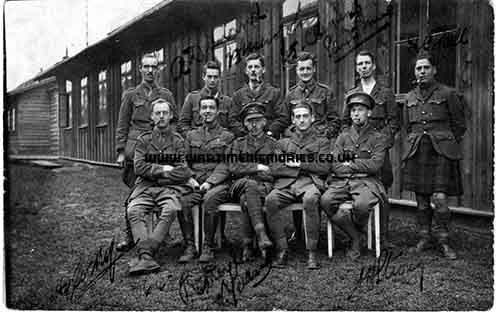Sgt Thomas "Squeak" Walsh MID Q Anti Aircraft Battery Royal Garrison Artillery
Army career of Thomas Walsh, Royal Garrison Artillery
Part 1
From a very early age, I grew up with a few snippets of stories of my grandfather’s involvement in the Great War told to me by my Mother.
Both my Brother Terence and I had a great interest it military history as teenagers. One of our favourite hobbies was building air fix models of tanks and equipment and staging war games with toy soldiers that went on for days sometimes.
Little did we know that on our mother’s side we had an undiscovered history of military men going back to my grandfather and great uncles.
On our mother's side, we had four close relatives who fought in the Great War. It was only much later in life that I decided to research my grandfather’s First World War service. I had with very little to go on except a few snippets from my mother.
With no detailed information, I considered it a lost cause, particularly when our mother told me that her sister Rose tried to get information about him. She had visited various military museums in London back in the 70's without success.
In addition, it was also quite common for veterans who returned not to speak about the war and even more so, for men who returned to Ireland given the volatile political situation here at the time.
There were various stories of events from relatives.
- ” He was gassed”
- “Mentioned in Dispatches”
- “His gun was hit and he was buried in a trench”
- “The only good German was a dead German.
It was at Aunty Jeanes’s funeral that my cousin Maria informed me that her dad, John, had his medals and his number, rank and unit were inscribed on the rim of three medals. This was the breakthrough I had being waiting for.
With help and assistance from members of the Great War Forum (a web site dedicated to helping people discover the British Army and its soldiers of the First World War) and a subscription to Ancestry I was ready to start my research.
Luckily, his service record survived the Blitz in 1940/1, which gave me an insight to his war service and lead me on a trial of discovery. Having dissected his army record and various Trench Mortar Batteries he was assigned to, you can see he was very much in the front line trenches in late 1914 and early 1915 in the Ypres Salient.
This action brought him in contact with various infantry battalions who were under constant fire from German mortars and gunfire. He suffered the same terrible conditions that front line troops endured, such as trench foot and trench fever.
By patiently researching regimental histories and battalion war diaries, and cross-referencing family anecdotage, I was able to piece together his military footsteps
There were three medals awarded to him: The British War Medal and Allied Victory Medal, awarded to all who served in the Great War. He was also awarded the 1914–Mons Star, awarded to those who served between 5th Aug.–22nd Nov. 1914. He was Mentioned in Dispatches in April 1917 at the Battle of Arras and received the Oak Leaf to wear on his Victory medal.
Army Career of Sergeant Thomas Walsh 30315 Royal Garrison Artillery
The first part will include a nonprofessional’s easy to understand approach to his Army service starting from when he joined the British Army until he was demobbed after 12 years’ service in 1919. He served out the remainder of his career on the Army B list reserve in Ireland.
The second part covers his military career, covering uniforms, war diaries, equipment, awards and casualty details and various events that took place while he was serving in the British Expeditionary Force from 1908-1920.
This is his story and I hope you will find it interesting and feel free to add any information you have, so I can make the history as complete as possible.
Thomas Walsh was born in the town of Donard in 1886. While he was 22 years of age in 1908 and working as a coachman for Doctor Louis Crinion in Kildare, he decided to join the British Army and see the world.
On the 4th of December 1908 he signed on at the recruitment centre in Nass Co Kildare in the Royal Artillery for a period of twelve years, he was given an enlistment number 30315, later to be renamed the Royal Garrison Artillery. He was passed fit after a medical examination and enlisted as Gunner Walsh Royal Regiment of Artillery (later know as Royal Garrison Artillery). On his enlistment form he gives his age as 22 and 2 months, height is 5 feet 8 inches with a fresh complexion with hazel eyes and dark brown hair.
He was posted to the 3rd Depot RGA. on the 29th August 1909, and received initial training. He left from Falmouth England for service abroad and arrived in Colombo, Ceylon 30 days later on the 30th September 1909.
During his training in Colombo, he met with an accident while training with the gun crew. His commanding officer wrote, “Gunner Walsh was employed on armament work at the time a piece of skidding fell on his big toe, he was not to blame”
During the period from September 1909 to 21 December 1912 he suffered from a number of incidents such as a boil, an injury to his left foot and his elbow and a bout of malaria which he was hospitalised for 3 months, was given quinine and recovered and put on weight.
He was awarded a good conduct badge and his commander officer noted him as a “sober reliable and hardworking soldier, he has some knowledge of driving and horses”.
In December 1912 after 3 years in Ceylon now (Sri Lanka) his unit was shipped home and posted to Spike Island in Co Cork Ireland
Gunner Walsh passed the Gun Layer proficiency exam on the 22 May 1914 at training Camp. He was the no 3 on the Gun; the gun layer got onto the aiming point, laid the gun and actually fired it. To be a qualified gun layer would have involved taking a test, usually against the clock, laying the gun accurately on different bearings. Qualification would have meant a slight pay increase.
Britain declares war on Germany 4th August 1914
The German Army had invaded Belgium in order to invade France, and Britain was committed to defending plucky little Belgium. Following the outbreak of The Great war Thomas Walsh was posted to the 114th Heavy Battery, Royal Garrison Artillery and crossed to France with his battery landing at Le Havre on the 4th of October 1914. Heavy RGA Batteries were equipped with heavy guns, sending large calibre high explosive shells in flat trajectory fire. The usual armaments were 60 pounders (5 inch) guns, although some had obsolescent 5-inch howitzers.
After a long march, under airplane fire, they arrived at a position near La Bassée. (La Bassée lies in France, southwest of Lille and about ten miles from the Belgian border). Here in the autumn of 1914 was fought one of the bloodiest battles of the Great War. His gun battery first came into action on the 31st of October 1914 and were complemented on their work by General Plummer. Gunner Walsh’s battery was responsible for putting a large German gun out of action at a range of 10,400 yards.
On the 2nd of November 1914, his battery was near Festubert. (The village of Festubert is a small French village located in the north of France) when it came under heavy German counter battery fire. His Lieutenant Charles Pierson was supervising the men into cover when a shell exploded between him and Battery Sergeant Major John Marks Gilbert, killing them both instantly. Lieut. Pierson was buried near the spot where he died. His wife received the following telegram dated the 5th of November 1914: -
"Deeply regret to inform you that Lieut. C.F.L. Pierson RGA was killed in action 2nd Nov. Lord Kitchener expresses his sympathy."
Gunner Walsh’s Division was amalagated with The Meerut Division (Indian Division) they were involved in the infamous 1914 Christmas Truce. Gunner Walsh was stationed with them in Richebourg L’Avoué the village of Richebourg-L'Avoué is in northern France.
On the 26th December 1914 he was admitted to hospital, No 12 in Rouen suffering from nephritis (Trench Fever). On the 4th January 1915 he was transferred to a hospital in England (location unknown)
By the end of 1914, the Allies and the Germans had established themselves in a line of trenches running from the Channel to the French-Swiss border. Until March 1915, artillery exchanges, sniping and mining operations were the main activities on the British Expeditionary Force’s (BEF) front. As both sides settled down for the first winter of the war, the weather proved harder to contend with than the enemy in some sectors.
Artillery bombardment rapidly destroyed trenches, which had been built quickly and tended to be simple affairs. The bad weather and the destruction of pre-war drainage ditches also led to widespread flooding. However, no matter how cold or wet they were, the soldiers had to remain in the line.
From the 6th January to the 7 March 1915, he was posted to a Trench Howitzer School at a base somewhere in the UK. He was trained in the use of a trench mortar. A mortar is cannon with a short barrel that fires shells in a high, arcing path. This allows the shells to travel over obstacles to hit a target. They were used in trench warfare, where they could be fired from inside a trench.
Inevitably, mortar positions rapidly came under fire from enemy artillery once their presence was detected. For this reason, they were unpopular when sited among a given group of infantrymen, for it almost guaranteed a busy time along the trench.
On the 8th March 1915, he returned back to France via Le Harve and on the 13th March was posted to the 22nd Trench Howitzer Battery in Zillebeke to prepare for the Second Battle of Ypres.
Extract from War Diary 22nd Trench Mortar Battery early 1915
Left Headquarters' Trench Mortar Howitzer School Berthen 14/2/1915, joining 28th Division in Action at Zonnebleke until 25/4/1915. In Action at Zillekebe 27/04/1915.
On the 10th May 1915 Gunner Walsh was admitted to the 3rd Stationery Hospital in Rouen suffering from Myalgia. (Trench Fever)
The stories of him being gassed, extract from War Dairy 22nd TMB 24th May 1915
24th May 1915 gas released at daybreak by enemy causing Royal Irish to retire and there was nothing for it but for gun detachments I NCO and 11 men to do the same. The guns were brought out of action owing to the men all being effected by the gas.
The above confirms that Gunner Walsh’s Mortar Battery was affected by the gas and had to leave the field. Coincidently (Joseph Cavanagh my great uncle) was with the Royal Irish Regiment and was wounded in the right arm on the same day 24 May 1915 near Shell Trap Farm later named Mouse Trap Farm
On the 12th June 1915, he was posted to the Trench Howitzer School 2nd Army in Berthen France while still attached to the 22nd Trench Mortar Battery.
Gunner Walsh was in the front line trench 80 yards from the German front line. He was operating one of these mortar guns, arrowed blue. This was an attack on the German trenches on the 6th July 1915 at Boesinghe in the Pilkem Sector. The map below was from the 22nd Trench mortar battery
In July 1915 20 TMB (1.5" mortars), 26 TMB (1.5" mortars) and 30 TMB (2" mortars) were all serving with Second Army in the Ypres sector By August they had been attached to 46, 6 and 12 Divisions respectively.
9th August 1915 Gunner Walsh was transferred to the 42nd Trench Howitzer Battery.
He returns back to the Trench Howitzer School on the 25th August 1915 at Berthen Howitzer School France for further training and at this time the new Stokes Mortar was been tested. Subsequently he was posted to 32nd Trench Howitzer Battery 5th September 1915 (War Diary gives details of engagements.) separate document
Another bout of trench fever on November 12, 1915 and he was admitted to 10th Casualty Clearing Station at Hazebrouck Siding France and then on to a Hospital in England on board HS Troup Ship Anglia on the 16th November 1917. The following day on the 17 November 1915, the Anglia was returning from Calais to Dover, carrying 390 injured officers and soldiers.
At around 12:30 pm, 1 nautical mile (1.9 km) east of Folkestone Gate, HMHS Anglia struck a mine laid by the German U-boat, UC-5 and sank in fifteen minutes. 134 people died in the sinking. A lucky escape for Gunner Walsh.
When he recovered from his sickness, he was posted to Shoeburyness on the South Coast of England in Essex, home to the Royal Artillery and Gunnery Schools. The newest addition was an Anti-Aircraft gunnery school. There he practised firing at Air Balloons over the sea.
22nd Trench Mortar Battery war diary 6, 7 , 8 July 1915 Boesingne.E. Pilkem Sector
Gunner Walsh was promoted to Bombardier on the 16 March 1916 while training at Shoeburyness artillery range. Also at Shoeburyness, war dogs were trained to return from an unknown position back to their kennels and taken further away from home each time. They were also taken to the gun batteries daily in order to become accustomed to the sound of gunfire.
The dogs were trained to relate to the firing of guns with food, so that the association would propel the dog to complete a message, run as fast as possible to receive their rations when they had finished. Terrier dogs were mainly used for this work and he may have got to like the Irish terrier, which he would breed and show after the war in the 1920s
6th April 1916: HM King George V visited Old and New Ranges at Shoeburyness
There are no war diaries for the period 1916-1918 for his AA battery so his army record such as promotions, illness and transfers and events cannot be traced
Bombardier Walsh remained in Shoeburyness until 25th April 1916 to prepare for the battle of the Somme offensive. He left Southampton for France on the 26 April 1916 with the 71st Anti-Aircraft Section.
27th April 1916 Bombardier Walsh was posted to 67th Anti-Aircraft Section (somewhere in France). In May 1916, he was admitted to Hospital with a high fever for 5 days.
On re-organisation of the various AA Units in November 1916, his battery became “Q” AA Battery Fifth Army 15 Anti-Aircraft Section `Q' Battery. In addition, it remained so until the end of the War.
Bombardier Walsh was promoted to Corporal on the 10th March 1917. He was appointed Acting Sergeant on the 9th of July 1917. Confirmed Sergeant on the 27 July 1917.
He was discharged for Army Reserve 3rd December 1920 after serving 12 years.
Sergeant Walsh was in action at Cambrai in 1917
Battle of Cambria November 1917
The preparations for the Battle of Cambrai in November 1917 were novel in many respects. For the first time, an air defence plan was an integral part of the overall scheme of attack. 7 AA Batteries were allotted to the front that was to be assaulted, and their covering fire swept up to 3500 yards ahead of the British line. 2 gun sections were made ready to follow up the advance.
With guns that had not been designed for the purpose and appropriate equipment late in being developed, the AA was perhaps more of a deterrent than an actually effective weapon. The complexities of deflection firing, weather conditions, target fixing, variable gun condition, etc. made for a very difficult operation. Training was all too brief, and methods experimental. Most of the gun Sections arrived in the field of battle without having fired a live shot. One source says that for example, in the busy week ending 27 April 1918, a total of 10 enemy aircraft were shot down and another 5 damaged, of a total of 2039 engaged.
End of the War
Soldiers of the regular army who were still serving their normal period of colour service remained in the army until their years were completed.
On arrival in England, the man would move to a Dispersal Centre. This was a hutted or tented camp or barracks. Here he received a Z3, Z11 or Z12 Protection Certificate and a railway warrant or ticket to his home station. This certificate enabled the man to receive medical attention if necessary during his final leave.
As long as the Military Service Act was enforced, all men who were liable for service under the Act who were not remaining with the colours in the regular army; or who had not been permanently discharged; or who were not on a Special Reserve or Territorial Force Reserve engagement were discharged into Class Z Army Reserve and liable to recall in the event of a grave national emergency. The man’s designated place of re-joining was shown on his Protection Certificate and Certificate of Final Demobilisation.
He spent 2 years and 151 days in France with his Battery before he obtained 10 days leave. Anti- Aircraft Sections Royal Garrison Artillery were equipped with two guns, usually of 3-inch calibre
The Section consisted of 43 men in total: 2 officers, two gun detachments of 12 men each (of which 1 in each was a Driver of the ASC), 2 telephonists, 1 linesman, 4 height finders, 4 Wilson-Dalby Detector Operators, 2 Height and Fuze Indicator men, 1 Order Board Setter, 1 Lookout man (Air sentry), 1 orderly and 1 cook.
All RGA unless indicated. Gun layer Royal Garrison Artillery. The Gun layer takes aim
Tom Walsh’s British army career
Highlighted years he spent fighting in Belgium/France.
- 4 December 1908 29 September 1908 Home Training England
- 30 September 1908 21 December 1912 Ceylon
- 22 December 1912 3 October 1914 Spike Island Cork
- 4th October 1914 5 January 1915 France BEF
- 6 January 1915 7 March 1915 Home Training England
- 8 March 1915 15 November 1915 France BEF
- 16 November 1915 15 April 1916 Home Training School
- 16 April 1916 14 September 1918 France BEF
- 15 September 1918 28 September 1918 Leave
- 29 September 1918 19 January 1919 France BEF
- 20 January 1919 17 February 1920 Home BEF
- 18 February 1920 3 December 1920 Home Army Reserve
Discharged for Army Reserve 3rd December 1920 after serving 12 years.
Pay rates for Artillery Soldiers Royal Garrison Artillery plus Armament Pay
- Lieutenant-Colonel 24s 6d 5s 0d
- Major 16s 0d 3s 6d
- Captain 13s 6d 2s 0d
- Lieutenant 9s 6d 1s 0d
- Second Lieutenant 8s 6d *1s 0d
- Quartermaster 10s 6d 0s 0d
* payable only if certified by Commanding Officer with regard to the
- Second Lieutenant’s technical efficiency
- Sergeant *3s 2d 3s 2d
- Corporal *2s 6d 2s 6d
- Bombardier *2s 3d 2s 3d
- Gunner **1s 2.5d 1s 2.5d
Medals Awarded to Thomas Walsh RGA 30315
Established in April 1917. Also known as 'Pip' or the 'Mons Star'.
King George V authorized this bronze medal award in April 1917 for those who had served in France or Belgium between 5th August 1914 to midnight on 22nd November 1914 inclusive. The award was open to officers and men of the British and Indian Expeditionary Forces, doctors and nurses as well as Royal Navy, Royal Marines, Royal Navy Reserve and Royal Naval Volunteer Reserve who served ashore with the Royal Naval Division in France or Belgium.
A narrow horizontal bronze clasp sewn onto the ribbon, bearing the dates '5th AUG. - 22nd NOV. 1914' shows that the recipient had actually served under fire of the enemy during that period. For every seven medals issued without a clasp there were approximately five issued with the clasp.
Recipients who received the medal with the clasp were also entitled to attach a small silver heraldic rose to the ribbon when just the ribbon was being worn.
The reverse is plain with the recipient's service number, rank, name and unit impressed on it. It should be remembered that recipients of this medal were responsible for assisting the French to hold back the German army while new recruits could be trained and equipped. Collectively, they fully deserve a great deal of honour for their part in the first sixteen weeks of the Great War. This included the battle of Mons, the retreat to the Seine, the battles of Le Chateau, the Marne, the Aisne and the first battle of Ypres. There were approximately 378,000 1914 Stars issued.
- The British War Medal, 1914-18 Established on 26th July 1919.
Also known as 'Squeak'.
The silver or bronze medal was awarded to officers and men of the British and Imperial Forces who either entered a theatre of war or entered service overseas between 5th August 1914 and 11th November 1918 inclusive. This was later extended to services in Russia, Siberia and some other areas in 1919 and 1920.
Approximately 6.5 million British War Medals were issued. Approximately 6.4 million of these were the silver versions of this medal. Around 110,000 of a bronze version were issued mainly to Chinese, Maltese and Indian Labour Corps. The front (obv or obverse) of the medal depicts the head of George V.
The recipient's service number, rank, name and unit was impressed on the rim.
Also known as 'Wilfred'
It was decided that each of the allies should each issue their own bronze victory medal with a similar design, similar equivalent wording and identical ribbon. The British medal was designed by W. McMillan. The front depicts a winged classical figure representing victory.
Approximately 5.7 million victory medals were issued. Interestingly, eligibility for this medal was more restrictive and not everyone who received the British War Medal ('Squeak') received the Victory Medal ('Wilfred'). However, in general, all recipients of 'Wilfred' also received 'Squeak' and all recipients of ‘Pip’ received both 'Squeak' and 'Wilfred'.
The recipient's service number, rank, name and unit was impressed on the rim.
- Mentioned in Dispatches (M.I.D.)
Tom Walsh was Mentioned in Dispatches in April 1917 (Battle of Arras) for rescuing his commandeering office in no man’s land after the gun was hit
“Mentioned in Despatches” is not an award of a medal, but as a commendation of an act of gallantry, it is included in this listing.
To be “Mentioned in Despatches” is when an individual is mentioned by name and commended for having carried out a noteworthy act of gallantry or service. A Despatch is an official report written by the senior commander of an army in the field. It would give details of the conduct of the military operations being carried out. From the time of the Boer War, the Dispatches were published in the London Gazette in full or in part. Winston Churchill (Morning Post, 6th October 1898) (4) used the phrase “Mentioned in Dispatches” for the first time in a newspaper article.
An individual could be Mentioned in Despatches more than once. As with the Victoria Cross, this commendation for an act of gallantry could be made posthumously.
In 1919, Army Order 166/1919 confirmed that individuals “Mentioned in Despatches” would receive a certificate. This included personnel of the British Navy, Army and Air Force, and Indian Dominion, Colonial, Egyptian Forces and members of the Red Cross, Y.M.C.A., Y.W.C.A. and British civilian is male and female.
In 1920 Army Order 3/1920 authorized the issue of an emblem to signify that an individual had been “Mentioned in Despatches” between 4th August 1914 and 10th August 1920. A bronze oak leaf was issued and could be worn on the ribbon of the British Victory Medal.
Gun Layers Badge worn on the Right shoulder sleeve












